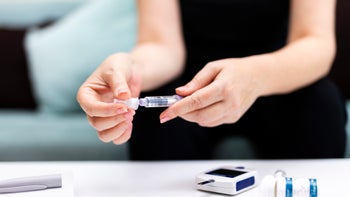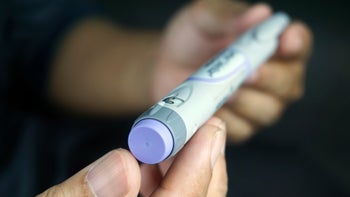Lantus
Lantus (insulin glargine) is a type of long-acting insulin. It's used to help manage blood sugar levels in people with Type 1 diabetes or Type 2 diabetes. Lantus (insulin glargine) is injected under the skin once daily. Your dose will depend on a few things, such as the type of diabetes you have and your blood sugar levels. This medication comes in a vial (Lantus) as well as in a prefilled insulin pen (Lantus Solostar). Some side effects include upper respiratory tract infections. It can also cause redness and swelling at the injection site.

What is Lantus (insulin glargine)?
What is Lantus (insulin glargine) used for?
Type 1 diabetes (T1D)
Type 2 diabetes (T2D)
How Lantus (insulin glargine) works
Lantus (insulin glargine) is a type of insulin for people with diabetes. This is important because they either can't make insulin, don't make enough insulin, or their body doesn't respond to insulin as it should.
Insulin is a hormone in your body that lowers glucose (sugar) levels in the blood in a few ways. It helps your body use sugar from your blood for energy. It also stops your liver from making glucose.
Drug Facts
More on Lantus (insulin glargine) essentials

Get your GoodRx coupon

What are the side effects of Lantus (insulin glargine)?
Common Side Effects
- Upper respiratory tract infection (22%)
- Other infection (9%)
- Accidental injury (6%)
- Headache (6%)
- Upper respiratory tract infection (11%)
- Other infection (10%)
- Eye problem (6%)
Other Side Effects
- Low blood sugar (hypoglycemia)
- Swelling in the arms, legs, or ankles
- Weight gain
- Injection site reaction (e.g., redness, pain, itching, swelling)
- Pitted skin or thickened skin at the injection site
Serious Side Effects
- Very low blood sugar: feeling shaky, nervous, anxious, sleepy, weak, or confused; fast heartbeat; sweating; body chills; feeling very hungry
- Very low potassium: weakness, muscle cramps or twitches, constipation, irregular heartbeat
- Severe allergic reaction: rash; hives; swelling of face, tongue, and throat; trouble breathing
Source: DailyMed
More on Lantus (insulin glargine) side effects
The following side effects have also been reported
Along with its needed effects, a medicine may cause some unwanted effects. Although not all of these side effects may occur, if they do occur they may need medical attention.
Check with your doctor immediately if any of the following side effects occur:
More common
behavior change similar to being drunk
blurred vision
chills
cold sweats
confusion
cool, pale skin
difficulty with thinking
dizziness or lightheadedness
drowsiness
excessive hunger
fast heartbeat
headache
nervousness
nightmares
restless sleep
seizures
shakiness
slurred speech
tingling in the hands, feet, lips, or tongue
unusual tiredness or weakness
Incidence not known
Bloating or swelling of the face, hands, lower legs, or feet
decreased urine
difficulty with swallowing
increased thirst
irregular heartbeat
muscle pain or cramps
numbness or tingling in the hands, feet, or lips
puffiness or swelling of the eyelids or around the eyes, face, lips, or tongue
rapid weight gain
vomiting
Some side effects may occur that usually do not need medical attention. These side effects may go away during treatment as your body adjusts to the medicine. Also, your health care professional may be able to tell you about ways to prevent or reduce some of these side effects. Check with your health care professional if any of the following side effects continue or are bothersome or if you have any questions about them:
Less common or rare
Depression of the skin at the injection site
itching, pain, redness, or swelling at the injection site
thickening of the skin at injection site
Other side effects not listed may also occur in some patients. If you notice any other effects, check with your healthcare professional.
Call your doctor for medical advice about side effects. You may report side effects to the FDA at 1-800-FDA-1088.

Pros and cons of Lantus (insulin glargine)

Pros
Helps keep your blood sugar controlled for about 24 hours
Injected once daily
Approved for both adults and children
Available as a vial and prefilled pen

Cons
Given as an injection under the skin
Has a risk of causing dangerously low blood sugar
Might cause weight gain
Can't be mixed with other insulins within the same syringe

Pharmacist tips for Lantus (insulin glargine)

Before your first time using Lantus (insulin glargine), review the tips on starting insulin. This can be helpful for knowing what to expect with insulin therapy. Ask your care team if you have any questions.
Lantus (insulin glargine) can cause low blood sugar as a side effect. Sometimes, it can get too low, which can be dangerous. You and your loved ones should know how to recognize and treat low blood sugar. Some symptoms include sweating, shakiness, anxiety, and hunger. Keep some fast-acting sugars with you to help get your blood sugar back up quickly.
You might need to use different types of insulins at different times of the day to help control your blood sugar. Always check the label on your insulins carefully. This helps you make sure you're using the right insulin at the right time. Double checking can help keep you from getting your insulins mixed up and having low blood sugar.
It's important to check your blood sugar levels regularly. This helps you keep track of how well Lantus (insulin glargine) is working. Share your blood sugar readings with your diabetes care team. They might adjust your insulin based on trends they see.
Make sure your meal plans and exercise routine are consistent. Don't make changes that are too drastic or sudden. This helps keep you blood sugar more steady while taking Lantus (insulin glargine). If you need to make big changes to your diet, meal patterns, or exercise, tell your care team. They might need to adjust your insulin.
How to use Lantus (insulin glargine):
Your diabetes care team will show you or your caregiver how to inject Lantus (insulin glargine). Read the Instructions for Use for the prefilled pen (Lantus Solostar) or vial and syringe (Lantus). If you have any questions, ask your care team.
Be sure you know how much Lantus (insulin glargine) you should inject. Don't change how much you inject unless your prescriber tells you it's okay. If you're not sure, ask your prescriber.
When to inject Lantus (insulin glargine): Inject the medication once daily at any time of day. It's best to inject around the same time each day so the medication works consistently for you.
For each Lantus (insulin glargine) injection: Use a new syringe and needle each time. Don't reuse them because this can cause infection. Remember, you'll need to get pen needles separately; they're not included with the pen.
Before injecting Lantus (insulin glargine): Check that the solution is clear and colorless without any particles. If it isn't, don't use the medication and ask your prescriber or pharmacist for a replacement. Don't dilute or mix Lantus (insulin glargine) with any other insulin or medication. Also don't put Lantus (insulin glargine) into an insulin pump. This might not be safe.
Where to inject Lantus (insulin glargine): Inject the medication under the skin of your stomach, thighs, or back of your upper arms. Choose a different spot to inject into each time to prevent skin irritation. Don't inject into pitted, thick, hard, scaly, bruised, or damaged areas of skin.
After the Lantus (insulin glargine) injection: Throw away any used needles and syringe in a sharps container. You can also use something made of heavy-duty plastic, like an empty milk carton or laundry detergent bottle. Don't throw away needles or syringes in your trash can. This helps keep you and others safe from needle sticks.
Unopened Lantus (insulin glargine) vials and pens: Store unopened vials and pens in the refrigerator until the expiration date. If needed, you can also keep them at room temperature (up to 86ºF) for up to 28 days.
Opened Lantus (insulin glargine) vials: Store opened vials in the refrigerator or at room temperature (up to 86ºF) for up to 28 days.
Opened Lantus (insulin glargine) pens: Keep opened pens at room temperature (up to 86ºF) for up to 28 days. After you start using a pen, don't put it in the refrigerator.
More on Lantus (insulin glargine) tips

Frequently asked questions about Lantus (insulin glargine)

How to save using GoodRx




What are the risks and warnings for Lantus (insulin glargine)?
Lantus (insulin glargine) can cause some serious health issues. This risk may be even higher for certain groups. If this worries you, talk to your doctor or pharmacist about other options.

Risk of infection from sharing pens and needles
Never share Lantus (insulin glargine) pens, syringes, or needles with anyone else. Don't let others use your pen even if you'd put on a new needle. Sharing Lantus (insulin glargine) and your injection supplies can raise the risk of spreading serious infections.

Risk of changes to blood sugar levels with changes to your insulin routine
Risk factors: Changes in insulin strength | Changes in type of insulins you use | Changes in insulin brand-name products | Suddenly changing where you inject
Making changes to your insulin routine can affect how your body responds to it. This can include suddenly changing where you inject Lantus (insulin glargine) or switching to a biosimilar. These changes can make your blood sugar go up or down. Also, injecting insulin repeatedly into pitted or thickened areas of skin can also cause higher blood sugar.
If your diabetes care team tells you to make any changes, be sure to follow their directions carefully. Also check your blood sugar more often. This will help you know how the changes affect you. Don't change your Lantus (insulin glargine) dose or routine without checking with your diabetes team first.

Low blood sugar (hypoglycemia)
Risk factors: Changes in meal patterns and exercise routine | Drinking alcohol | Taking other medications for diabetes | Liver or kidney problems | Not using Lantus (insulin glargine) as directed
Lantus (insulin glargine) can cause low blood sugar, or hypoglycemia. Sometimes, your blood sugar can get too low. This can be dangerous and even life-threatening if not treated in time. Be sure to follow your prescriber's instructions and check your blood sugar regularly.
Make sure you're familiar with the signs of low blood sugar so you can catch it early. You might feel shaky, dizzy, sweaty, clammy, nervous, irritated, or confused. You could also have trouble paying attention or reacting quickly, which can be risky while driving. Keep in mind that low blood sugar can happen suddenly and look different for everyone.
It's important to know how to treat low blood sugar. Keep fast-acting sugars, such as glucose tablets, with you at all times while you're taking Lantus (insulin glargine). This can help raise your blood sugar quickly. If you have low blood sugar, treat it right away and let your diabetes team know. If it doesn't improve, get medical help right away.

Low potassium levels
Risk factors: Taking other medications that lower your potassium
Lantus (insulin glargine) can lower your potassium levels, which can sometimes be dangerous. You're at greater risk if you also take other medications that can cause low potassium, such as diuretics. If you're at risk, your prescriber might check your potassium levels with blood tests.
You might not have symptoms until your potassium drops quite low. But be aware of signs of low potassium while taking Lantus (insulin glargine). These can include weakness, muscle cramps or twitches, constipation, and a racing heart. If this happens, let your prescriber know right away.

Swelling and risk of heart failure when using with certain diabetes medications
Risk factors: Taking glitazones together with insulin | History of heart failure
Taking Lantus (insulin glargine) with diabetes medications called glitazones, like pioglitazone (Actos), can cause your body to hold onto extra fluid. It can lead to or worsen heart failure. This is because the extra fluid can put stress on the heart.
Before you start Lantus (insulin glargine), tell your prescriber if you have heart failure. Also tell them if you take other diabetes medications. They can make sure Lantus (insulin glargine) is safe for you and check in with you more often.
Let your care team know if you have swelling in your legs or ankles while you're taking Lantus (insulin glargine). Also tell them if you feel very tired or short of breath. These could be signs of fluid buildup or heart failure.

Severe allergic reaction
Rarely, Lantus (insulin glargine) can cause a severe allergic reaction that can be life-threatening. This can include anaphylaxis. A severe allergic reaction can look like swelling in your lips, face, or tongue; rash; or trouble breathing. If this happens, get medical help right away.

Lantus (insulin glargine) dosage forms
Typical dosing for Lantus (insulin glargine)
Your diabetes care team will work with you to determine your dose. The dose will be different for each person.
Type 1 diabetes: Your care team will use your total daily insulin (TDI) requirement to find the dose of Lantus (insulin glargine) for you. The typical starting dose is about 30% of your TDI requirement. Inject Lantus (insulin glargine) under the skin once daily. Use along with a pre-meal short-acting or rapid-acting insulin.
Type 2 diabetes: Your care team will calculate your starting dose based on your body weight. The typical starting dose is 0.2 units/kg (or up to 10 units) each day. Inject Lantus (insulin glargine) under the skin once daily.
Your care team will adjust your dose depending on your blood sugar levels.
More on Lantus (insulin glargine) dosage forms

Interactions between Lantus (insulin glargine) and other drugs
More on Lantus (insulin glargine) interactions
Using this medicine with any of the following medicines is usually not recommended, but may be required in some cases. If both medicines are prescribed together, your doctor may change the dose or how often you use one or both of the medicines.
- Balofloxacin
- Besifloxacin
- Ciprofloxacin
- Enoxacin
- Fleroxacin
- Flumequine
- Gatifloxacin
- Gemifloxacin
- Lanreotide
- Levofloxacin
- Liraglutide
- Lomefloxacin
- Metoclopramide
- Metreleptin
- Moxifloxacin
- Nadifloxacin
- Norfloxacin
- Octreotide
- Ofloxacin
- Pasireotide
- Pazufloxacin
- Pefloxacin
- Pioglitazone
- Pramlintide
- Prulifloxacin
- Rosiglitazone
- Rufloxacin
- Sparfloxacin
- Thioctic Acid
- Tosufloxacin
Using this medicine with any of the following medicines may cause an increased risk of certain side effects, but using both drugs may be the best treatment for you. If both medicines are prescribed together, your doctor may change the dose or how often you use one or both of the medicines.
- Acebutolol
- Albiglutide
- Atenolol
- Betaxolol
- Bisoprolol
- Carteolol
- Carvedilol
- Celiprolol
- Dulaglutide
- Esmolol
- Exenatide
- Furazolidone
- Iproniazid
- Isocarboxazid
- Labetalol
- Levobunolol
- Linezolid
- Lixisenatide
- Methylene Blue
- Metipranolol
- Metoprolol
- Moclobemide
- Nadolol
- Nebivolol
- Nialamide
- Oxprenolol
- Penbutolol
- Phenelzine
- Pindolol
- Practolol
- Procarbazine
- Propranolol
- Rasagiline
- Safinamide
- Selegiline
- Sotalol
- Timolol
- Tranylcypromine

How much does Lantus (insulin glargine) cost?

Lantus (insulin glargine) contraindications
When you have low blood sugar levels
Allergy to Lantus (insulin glargine) or other insulin glargine products

What are alternatives to Lantus (insulin glargine)?

What is the latest news about Lantus (insulin glargine)?

Lantus (insulin glargine) images
Get savings updates for Lantus (insulin glargine)
Receive price alerts, news, and other messages from GoodRx about Lantus (insulin glargine) and other healthcare topics and relevant savings offers.By providing your email, you consent to receive marketing communications from GoodRx, which may include content and/or data related to men’s health, women's health, reproductive care, or sexual health. You agree to the GoodRx Terms of Use and acknowledge the Privacy Policy. You can unsubscribe at any time.
References
Best studies we foundAmerican Diabetes Association. (2012). Hypoglycemia? Low blood glucose? Low blood sugar? Clinical Diabetes.
Sanofi-aventis U.S. LLC. (2022). How to use your Lantus® SoloStar® pen.
Sanofi-aventis U.S. LLC. (2022). Injecting Lantus® with a vial and syringe.
Sanofi-aventis U.S. LLC. (2025). Lantus- insulin glargine injection, solution; LANTUS SoloStar- insulin glargine injection, solution [package insert]. DailyMed.
You and Your Hormones. (2021). Insulin.
Compare other Diabetes Type 2, Diabetes Type 1 drugs
Browse medications
View AllResearch prescriptions and over-the-counter medications from A to Z, compare drug prices, and start saving.




















